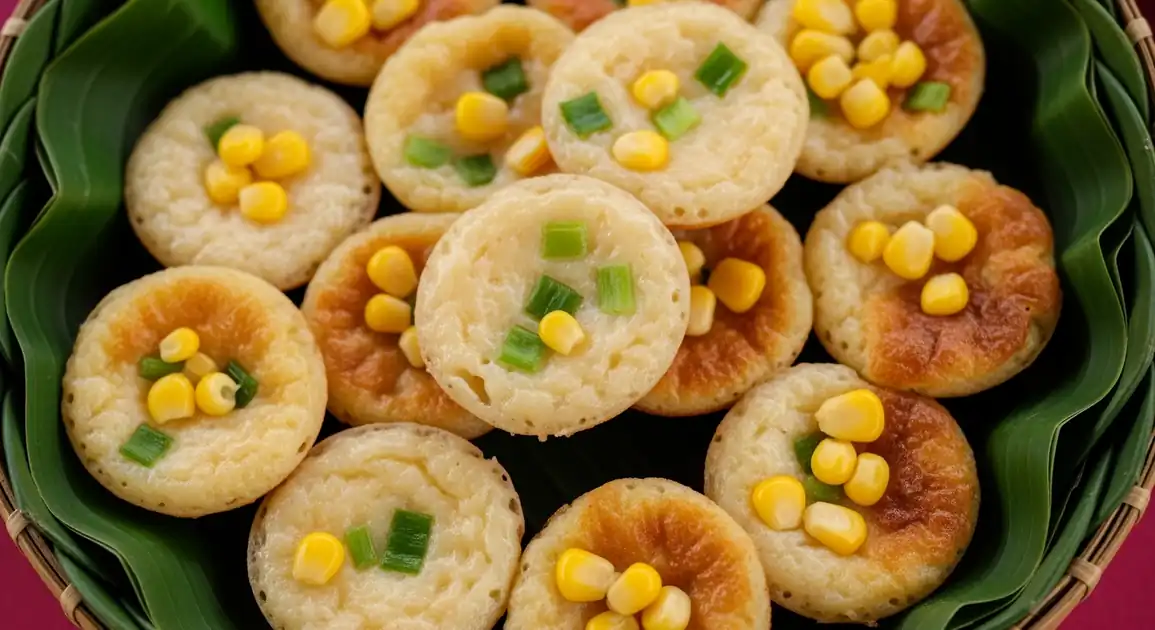Coconut Pancakes (Khanom Krok)
ขนมครก (Khanom Krok)

Description
Khanom Krok is a beloved traditional snack found throughout Thailand, from bustling city markets to small village stalls. Typically enjoyed as a morning treat, these coconut pancakes represent the perfect balance of Thai culinary elements: crispy exterior, creamy interior, and harmonious sweet-salty flavor profile. While regional variations exist, the essential character of this dish remains consistent across the country.
Dietary Information
Serving information
Serving style
Typically served in small biodegradable containers made from banana leaves, paper, or styrofoam with a wooden skewer for eating. Usually eaten fresh while still warm.
Quick facts
Morning vendors: 5 AM - 10 AM; Evening/market vendors: 4 PM - 10 PM
Safety Tips
What to Look For
-
Pancakes cooked fresh to order
Fresh batches ensure both safety and optimal texture. Look for vendors actively cooking rather than those with pre-made pancakes sitting out.
-
Proper coconut milk storage
Fresh coconut milk spoils easily in hot weather. Look for vendors who keep it chilled or in small batches that are used quickly.
-
Clean, well-maintained cooking pans
The specialty cast iron pans should be clean and properly seasoned. Poorly maintained pans can harbor bacteria and affect flavor.
-
Covered toppings and ingredients
Fresh toppings like corn, green onions, and taro should be kept covered to protect from insects and environmental contamination.
What to avoid
-
Pre-made pancakes sitting at ambient temperature
Due to their high moisture content and coconut milk base, Khanom Krok can spoil quickly when left unrefrigerated, especially in Thailand's heat.
-
Sour or off-smelling coconut aroma
Coconut milk spoils quickly. Any sour smell indicates the mixture may have started fermenting, especially in hot weather.
-
Vendors with poor hygiene practices
Avoid vendors who handle money and food without washing hands or changing gloves, or whose stalls appear generally unclean.
-
Undercooked centers
While centers should be soft and creamy, they shouldn't be completely liquid or raw. Proper cooking ensures food safety.
Price information
Price range
Budget tips
- Street vendors typically charge 20-30 THB for 6-8 pieces
- Market stalls often offer better value than touristy areas
- Morning markets generally have lower prices than evening markets or shopping malls
- Some vendors offer a discount if you buy multiple sets
Value indicators
- Freshly made upon ordering
- Generous portion sizes (at least 6-8 pieces per order)
- Multiple topping options included in the base price
- Proper thickness and size (not too thin or small)
Where to Find This Dish
Morning Markets
Fresh morning markets typically host several Khanom Krok vendors with the freshest ingredients
Local fresh markets, Temporary morning street markets
5 AM - 9 AM
Night Markets
Evening food markets now commonly feature Khanom Krok vendors catering to tourists and locals alike
Tourist night markets, Local evening fresh markets
6 PM - 10 PM
Weekend Markets
Large weekend markets often have established vendors with loyal followings
Chatuchak Weekend Market (Bangkok), Saturday/Sunday walking streets
Morning, Afternoon
Vendor Tips
- Vendors with traditional charcoal setups often produce more authentic flavors than those using gas
- Look for vendors who prepare their own coconut milk rather than using packaged versions
- Vendors with a good system for managing batches (not rushing the cooking process) typically produce better quality
How to Order
Regional Variations
-
Classic Khanom Krok
(ขนมครกธรรมดา (Khanom Krok Thammada))
The traditional version with just coconut milk, rice flour, and sugar, featuring a crispy edge and creamy center without additional toppings.
-
Corn Khanom Krok
(ขนมครกข้าวโพด (Khanom Krok Khao Pod))
Topped with sweet corn kernels, adding texture and natural sweetness that complements the coconut base.
-
Green Onion Khanom Krok
(ขนมครกต้นหอม (Khanom Krok Ton Hom))
Sprinkled with chopped green onions, providing a savory contrast to the sweet coconut pancake.
-
Taro Khanom Krok
(ขนมครกเผือก (Khanom Krok Phueak))
Includes small pieces of purple taro, adding visual appeal and a subtle, earthy flavor.
-
Pumpkin Khanom Krok
(ขนมครกฟักทอง (Khanom Krok Fak Thong))
Contains small chunks of sweet pumpkin, adding natural sweetness and a soft texture.
-
Coconut Meat Khanom Krok
(ขนมครกเนื้อมะพร้าว (Khanom Krok Nuea Maprao))
Includes shredded young coconut meat for added texture and an enhanced coconut flavor.
Cultural context
History
Khanom Krok has ancient roots in Thai cuisine, with some culinary historians tracing variants back to the early Sukhothai period (13th-15th centuries). The dish likely has influences from Indian appam and Chinese cooking techniques. Originally a palace dessert, it evolved into popular street food as specialized pans became more accessible. The balanced flavor profile represents Thai culinary philosophy of incorporating sweet, salty, and creamy elements into a harmonious whole.
Local significance
Khanom Krok represents traditional Thai culinary artistry through its specialized cooking equipment and technique. As morning markets modernize or disappear, it remains a connection to Thailand's culinary heritage.
Eating customs
- Eaten while still warm but not hot enough to burn
- Consumed as a snack rather than a dessert course in a meal
- Often enjoyed with Thai tea or coffee in the morning
- Typically eaten with hands or the provided wooden skewer